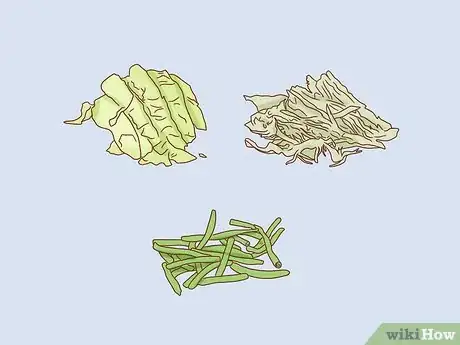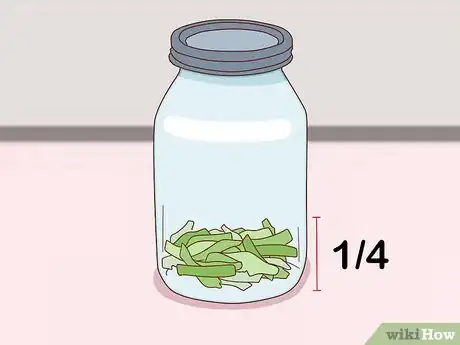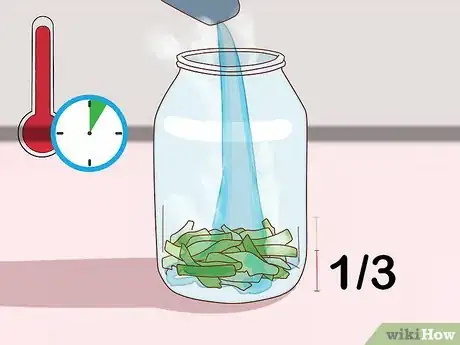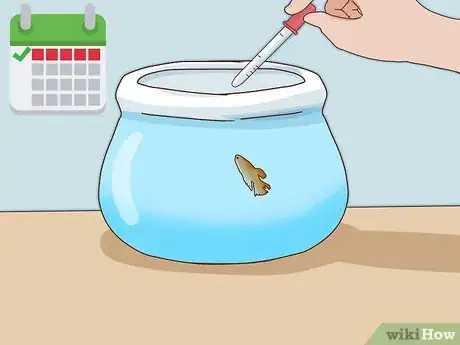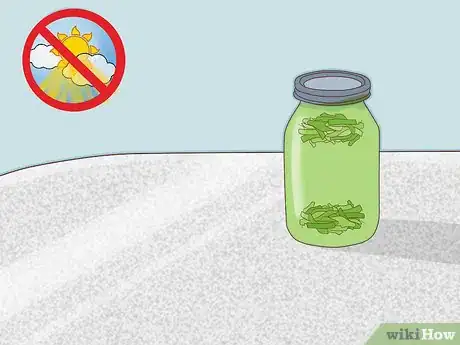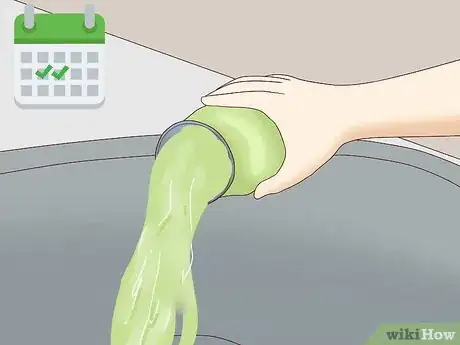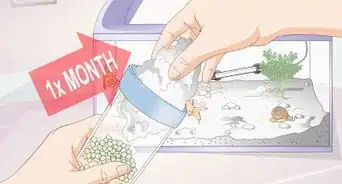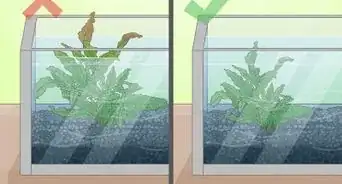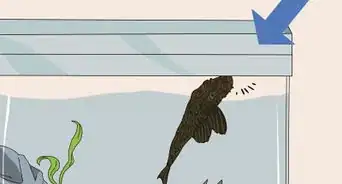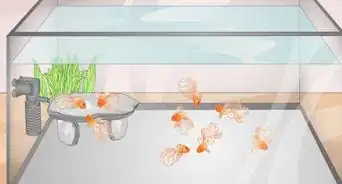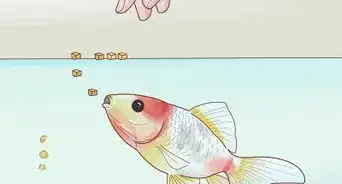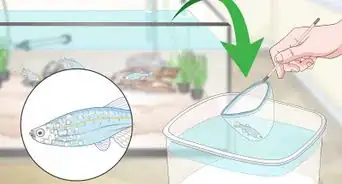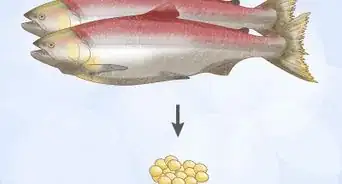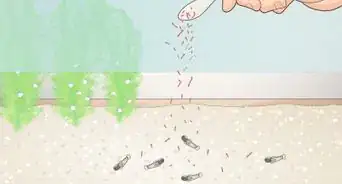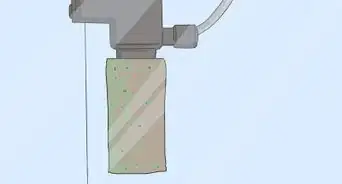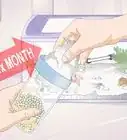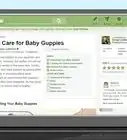This article was co-authored by wikiHow staff writer, Jessica Gibson. Jessica Gibson is a Writer and Editor who's been with wikiHow since 2014. After completing a year of art studies at the Emily Carr University in Vancouver, she graduated from Columbia College with a BA in History. Jessica also completed an MA in History from The University of Oregon in 2013.
There are 7 references cited in this article, which can be found at the bottom of the page.
wikiHow marks an article as reader-approved once it receives enough positive feedback. In this case, 89% of readers who voted found the article helpful, earning it our reader-approved status.
This article has been viewed 300,122 times.
Learn more...
Would you love to help your fish fry grow faster? Instead of buying nutritious microorganisms called infusoria, make your own with a little leftover produce. Combine a few pieces of leafy greens or vegetables in a jar with water from an established tank. Then leave it in the sunshine so the produce makes bacteria for the infusoria to feed on. Use an eye dropper to feed your fish fry a few drops of water that are rich with the infusoria and watch them grow!
Steps
Culturing the Infusoria
-
1Choose vegetables to make the infusoria starter. You can use canned or fresh vegetables as the base for the infusoria. If you like, use more than 1 type of vegetable, which will encourage a variety of microorganisms to grow. Consider using:[1]
- Chopped lettuce or spinach leaves
- Shredded green cabbage
- Green beans
- Peas
-
2Fill a 1 US quart (950 ml) jar 1/4 full with the vegetables. Chop the leafy greens into 1 to 2 inches (2.5 to 5.1 cm) pieces before you put them into the jar and shell green beans or peas. Put both the shells of the green beans and the peas into the jar.[2]
- Chopping the vegetables will help it break down faster in the water.
Advertisement -
3Fill the jar 1/3 full with boiling water and let it cool for 5 minutes. Bring a kettle of water to boil and carefully pour boiling water over the vegetables in the jar. Pour slowly until the jar is 1/3 full with boiling water. Then let the water cool until it's simply warm.[3]
- The jar should be warm or at room temperature. If it's cold, it may shatter when you pour the boiling water into it.
-
4Pour in aquarium water to fill the jar. Once the water in the jar is just warm to the touch, slowly pour in water from an established aquarium. Keep pouring until the jar is full of water.[4]
- It's fine if a little debris from the aquarium gets into the jar.
- The water from the aquarium will have microorganisms that will help your infusoria grow.
-
5Set the jar in a sunny place near a window. Move the jar to a windowsill where it will get sunshine throughout the day. While you don't need to seal the jar shut, you can place a light cloth, such as cheesecloth, over the top to prevent things from falling into the jar.
- Sunshine will encourage the vegetables to break down. This will create bacteria for the infusoria to eat.
-
6Wait 2 to 3 days for the infusoria to develop. You'll notice the water become cloudy, which means that bacteria is starting to grow. As the infusoria grow, the water will become clearer because the infusoria is feeding on the bacteria. This is how you know the infusoria is ready to feed to your fish fry.[5]
- Although cloudy water means the infusoria will soon be ready, don't use it until the water clears.
Tip: If you see scum form at the top of water, swirl the jar gently. This will ensure that oxygen reaches the material down in the jar.
Using and Storing Infusoria
-
1Use the dropper to feed the fry a few drops of infusoria twice a day. Insert a clean eye dropper or turkey baster into the middle of the jar with the infusoria. Remove some of the liquid and squirt a few drops into the fish tank that has your fry in it. Since the fry are growing quickly, feed them infusoria at least 2 times a day.[6]
- Remember that you don't need to add very much liquid from the jar since infusoria are so small and there are a lot of them in a single drop of the liquid.
-
2Feed the fry infusoria for about 1 week. Continue to feed the infusoria to your fish fry until they're big enough to start eating larger foods, such as brine shrimp nauplii. You should see the fry develop and grow quickly.[7]
- If you put too much infusoria liquid into the tank with the fish fry, the water may turn cloudy.
Tip: If you'd like to have a batch of infusoria ready for when you discard your initial batch, start a new jar 3 to 4 days after starting the first.
-
3Store the infusoria at room temperature. Keep the infusoria alive by avoiding extreme swings in temperature. Instead of storing the jar of infusoria in the refrigerator, leave it at room temperature. To slow down the development of bacteria and infusoria, remove the jar from the window and put it on a counter out of direct sunlight.[8]
- To prevent things from falling into the jar, lay a piece of cheesecloth or a light towel over the top. Avoid screwing a lid tightly onto the jar because this will cause the food in the jar to spoil faster.
-
4Discard the infusoria after 2 days. Once the infusoria has developed enough to feed to your fish fry, plan on using it within 2 days. After 2 days, the infusoria won't develop and bacteria will overwhelm the jar. This will make the water cloudy again. You'll also notice a rotting smell coming from the produce in the jar.[9]
- Consider labeling the jar with the date you originally set it in the window, the date the infusoria was developed enough to use, and the date you need to discard it.
Community Q&A
-
QuestionCan I use any plant instead of lettuce?
 Community AnswerYes, you can use almost any plant leaves that are not poisonous. For example, grass, tree leaves, and cucumber skin.
Community AnswerYes, you can use almost any plant leaves that are not poisonous. For example, grass, tree leaves, and cucumber skin. -
QuestionWhat's the other alternative of algae water?
 Community AnswerYou can buy Copepod cultures at your LFS or online. Almost the same process, but you'll want to maintain your culture with aged aquarium water (after a water change) or rain water. Put the container you chose to use under direct light for 48-72 hours for bacteria and phytoplankton to grow for copepods to eat and you're set. Or, if you have a spacious, well-off tank, your fry can survive off of the ecosystem of the tank. I've left fry in the same tank as they were born, yes a couple were eaten, and they've grown into full adults in a 10 gallon tank.
Community AnswerYou can buy Copepod cultures at your LFS or online. Almost the same process, but you'll want to maintain your culture with aged aquarium water (after a water change) or rain water. Put the container you chose to use under direct light for 48-72 hours for bacteria and phytoplankton to grow for copepods to eat and you're set. Or, if you have a spacious, well-off tank, your fry can survive off of the ecosystem of the tank. I've left fry in the same tank as they were born, yes a couple were eaten, and they've grown into full adults in a 10 gallon tank. -
QuestionCan I use cabbage instead of lettuce?
 Community AnswerYes. I have used cabbage because I live in India and lettuce is not available here.
Community AnswerYes. I have used cabbage because I live in India and lettuce is not available here.
Things You'll Need
- 1 US quart (950 ml) jar
- Turkey baster or dropper
- Vegetables
- Light cloth or cheesecloth, optional
References
- ↑ https://youtu.be/wK-Ub-6y5Rw?t=39
- ↑ https://youtu.be/wK-Ub-6y5Rw?t=50
- ↑ https://youtu.be/wK-Ub-6y5Rw?t=65
- ↑ https://youtu.be/0s-nwWB7oTE?t=39
- ↑ https://youtu.be/wK-Ub-6y5Rw?t=92
- ↑ https://www.ratemyfishtank.com/blog/how-to-culture-infusoria-for-baby-fish
- ↑ https://www.ratemyfishtank.com/blog/how-to-culture-infusoria-for-baby-fish
- ↑ https://www.researchgate.net/post/What_is_the_best_method_to_obtain_a_good_paramecium_culture
- ↑ https://www.researchgate.net/post/What_is_the_best_method_to_obtain_a_good_paramecium_culture
About This Article
If you want to make your fish grow faster, make your own infusoria, which is a microorganism that you can grow with a little leftover produce. Use canned or fresh vegetables, like chopped lettuce, green beans, or peas, as the base for your infusoria. Fill a 1-quart jar ¼ full with the vegetables, then pour boiling water over them until the jar is ⅓ full. When the water cools to room temperature, add aquarium water to fill the jar. Set your jar in a sunny place near a window to help the vegetables break down and create bacteria for the infusoria to eat. Wait 2 to 3 days for the infusoria to develop. You’ll know the infusoria is ready when the water clears. You can then feed your fish a few drops of infusoria twice a day. To learn how to store your infusoria, keep reading!
